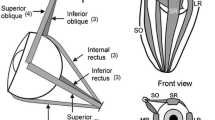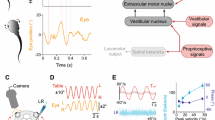Summary
-
1.
Horizontal eye and head movements made by freely swimming goldfish have been recorded cinematographically and analyzed frame-by-frame.
-
2.
Most horizontal eye movements occur during turns. A binocular saccade precedes a turn, and the eyes counterrotate relative to the head as the turn progresses, thus keeping a nearly constant orientation in space. The subsequent saccades reset the eyes from an intermediate position to an extreme one.
-
3.
Both the saccades and the compensatory movements are generally unequal in the two eyes. The rotation by the eye on the outside of a turn exceeds that of the inner one, which undercompensates.
-
4.
The compensation factor, CF, defined as the ratio of (mean binocular rotation relative to the head)/(head rotation), is variable from turn to turn, but averages 0.95±0.10 (mean±2 S.E.M.).
-
5.
The slight undercompensation by the inside eye, when coupled with forward movement by the fish, results in relative visual stabilization of a region of space some tens of centimeters or less lateral to the animal. This stabilized region changes with each saccade.
Similar content being viewed by others
References
Charman, W. N., Tucker, J.: The optical system of the goldfish eye. Vision Res.13, 1–8 (1973)
Duntley, S. Q.: Light in the sea. J. opt. Soc. Amer.53, 214–233 (1963)
Easter, S. S.: Spontaneous eye movements in restrained goldfish. Vision Res.11, 333–343 (1971)
Easter, S. S.: Pursuit eye movements in goldfish (Carassius auratus). Vision Res.12, 673–688 (1972)
Easter, S. S., Johns, P. R.: Horizontal compensatory eye movements in goldfish (Carassius auratus). II. A comparison of normal and deafferented animals. J. comp. Physiol.92, 37–57 (1974)
Harris, A. J.: Eye movements of the dogfishSqualus acanthias L. J. exp. Biol.43, 107–130 (1965)
Hermann, H. T., Constantine, M.: Eye movements in the goldfish. Vision Res.11, 313–333 (1971)
Lowenstein, O.: The labyrinth. In: Fish physiology, vol. V, p. 207–241 (ed. Hoar, W. D., and D. J. Randall). New York: Academic Press 1971
Rowley, J. B.: Discrimination of pattern and size in the goldfishCarassius auratus. Genet. Psychol. Monogr.15, 245–302 (1934)
Walls, G. L.: The evolutionary history of eye movements. Vision Res.2, 69–80 (1962)
Wartzok, D., Marks, W. B.: Directionally selective visual units recorded in optic tectum of the goldfish. J. Neurophysiol.36, 588–605 (1973)
Author information
Authors and Affiliations
Additional information
This work was supported by grant EY-00168 from the National Eye Institute of the United State Public Health Service.
We thank Drs. M. Alpern and R. Knighton for useful critical discussions, C. Gans for the extended loan of the motion picture analyzer, Mr. L. Martonyi for photographic services, Ms. J. Smith for typing, and the staff of the Statistical Research Laboratory for the use of the MIDAS Program.
Rights and permissions
About this article
Cite this article
Easter, S.S., Johns, P.R. & Heckenlively, D. Horizontal compensatory eye movements in goldfish (Carassius auratus). J. Comp. Physiol. 92, 23–35 (1974). https://doi.org/10.1007/BF00696524
Received:
Issue Date:
DOI: https://doi.org/10.1007/BF00696524




